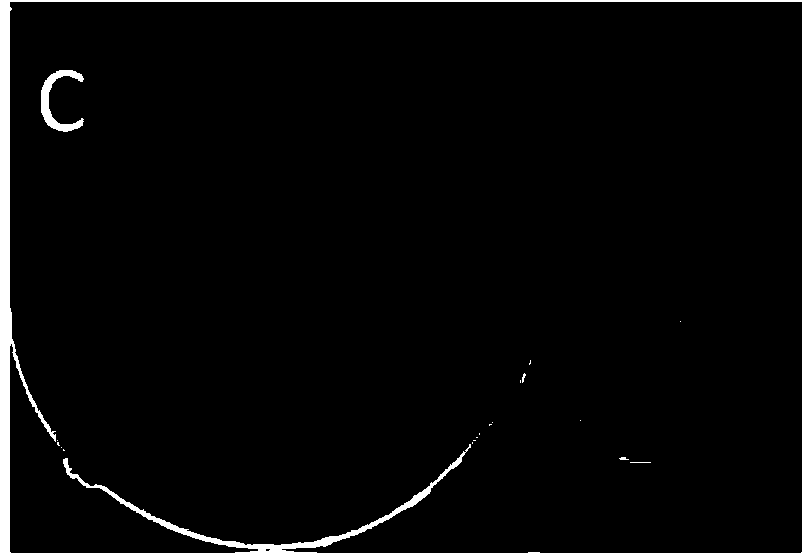Silicon-carbon composite microsphere anode material and preparation method thereof
A technology of composite microspheres and silicon-carbon composites, applied in the direction of negative electrodes, battery electrodes, active material electrodes, etc., can solve the problems of unstable negative electrode material structure, insufficient isolation of electrolyte, unfavorable large-scale production, etc., and achieve low cost , easy to operate, reduce the effect of stress damage
- Summary
- Abstract
- Description
- Claims
- Application Information
AI Technical Summary
Problems solved by technology
Method used
Image
Examples
preparation example Construction
[0026] An embodiment of the present invention provides a method for preparing a silicon-carbon composite microsphere negative electrode material, comprising the following steps: firstly mixing nano-silicon particles and a first polymer solution, spraying and drying to form a first composite microsphere; and then mixing the second A composite microsphere is mixed with a second polymer solution, the surface of the first composite microsphere is coated, and after the solvent evaporates, a second composite microsphere with a core-shell structure is formed; finally, the second composite microsphere is The spheres are oxidized and carbonized to form silicon-carbon composite microsphere anode materials.
[0027] In a preferred embodiment of the present invention, the first polymer solution includes polyvinyl alcohol solution, and the second polymer solution includes polyacrylonitrile solution.
[0028] The silicon-carbon composite microsphere negative electrode material and its prepa...
example 1
[0030]The first step: solution preparation. This example uses polyvinyl alcohol (PVA) with a molecular weight of about 20,000 g / mol, polyacrylonitrile (PAN) with a molecular weight of about 15,000 g / mol, and nano-silicon particles (Si) with a diameter of less than 100 nm. First weigh a certain amount of PVA, add it to a certain amount of deionized water, stir at 90°C for 2 hours to dissolve, and prepare a PVA aqueous solution with a mass fraction of 1%; weigh it according to the mass ratio of nano-silicon particles to PVA is 1:10 Add a certain amount of nano-silicon particles into the PVA aqueous solution, continue to stir at 80° C. for 2 hours, and ultrasonically disperse for 2 hours to uniformly disperse the nano-silicon particles in the PVA aqueous solution to obtain a PVA-Si dispersion mixture. A certain amount of PAN was weighed, added to a certain amount of N,N-dimethylformamide (DMF), stirred at 80° C. for 5 h to dissolve, and a PAN / DMF solution with a mass fraction of ...
example 2
[0044] The difference between this example and Example 1 is that the mass fraction of the PVA aqueous solution prepared in this example is 3%. The silicon-carbon composite microsphere anode material prepared in this example is subjected to the electrochemical performance test as in Example 1. The test result is: when the cycle performance test is performed at a current of 0.1A / g, the first reversible capacity is 939mAh / g, and the coulombic efficiency is 939mAh / g. The reversible capacity after 100 cycles is 763mAh / g, and the capacity retention rate is 81%. In the rate performance test, the reversible capacity under 2.0A / g current is 537mAh / g.
PUM
| Property | Measurement | Unit |
|---|---|---|
| Diameter | aaaaa | aaaaa |
| Diameter | aaaaa | aaaaa |
| Molecular weight | aaaaa | aaaaa |
Abstract
Description
Claims
Application Information
 Login to View More
Login to View More - Generate Ideas
- Intellectual Property
- Life Sciences
- Materials
- Tech Scout
- Unparalleled Data Quality
- Higher Quality Content
- 60% Fewer Hallucinations
Browse by: Latest US Patents, China's latest patents, Technical Efficacy Thesaurus, Application Domain, Technology Topic, Popular Technical Reports.
© 2025 PatSnap. All rights reserved.Legal|Privacy policy|Modern Slavery Act Transparency Statement|Sitemap|About US| Contact US: help@patsnap.com



